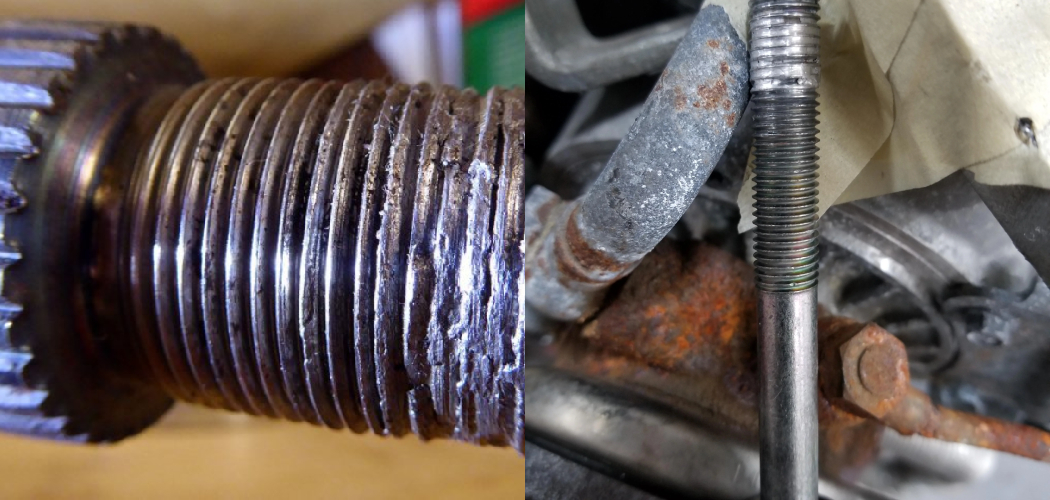In the realm of home improvement and mechanical endeavors, nothing can be more infuriating than encountering a cross-threaded screw or bolt. It’s like a stubborn enigma that halts your progress, leaving you with a nagging feeling of frustration. But fret not, for in this comprehensive guide, we will unravel the mysteries of cross-threading, empowering you with techniques and tips to rectify these vexing situations.

Image: mikerobertsconstruction.com
Understanding Cross-Threading: A Tale of Misalignment
Cross-threading occurs when a screw or bolt is not aligned correctly with the threads of the receiving hole. This misalignment results in the threads grinding against each other instead of engaging smoothly. As a consequence, the threads can become damaged, making it difficult or even impossible to tighten or remove the fastener.
Rescuing a Cross-Threaded Screw or Bolt: Strategies to Rectify the Mishap
Fear not, for there are a myriad of strategies at your disposal to tackle a cross-threaded screw or bolt:
Option 1: Back Out and Re-Align
If the cross-threading is minimal, you may be able to carefully back out the screw or bolt and re-insert it at a corrected angle. Gently turn the fastener counterclockwise to disengage the threads, being mindful not to apply excessive force. Once removed, inspect the threads for any damage. If the damage is superficial, you may be able to proceed with re-inserting the fastener with increased care.

Image: repairious.com
Option 2: Recut the Threads
In cases where the cross-threading has caused more severe damage, you may need to recut the threads. This can be achieved using a thread repair kit, which includes a tap and die designed to match the thread pitch and diameter of the damaged fastener. Use the tap to re-establish the threads in the hole, and then follow with the die to re-create the threads on the screw or bolt. This method provides a more permanent and secure repair.
Option 3: Extract the Cross-Threaded Fastener
If the cross-threading is too severe to rectify, you may need to extract the damaged fastener. There are several methods available for fastener extraction:
- Needle-Nose Pliers: If the screw or bolt head is exposed, you may be able to grip it with needle-nose pliers and carefully remove it.
- Screw Extractors: These specialized tools are designed to bite into a damaged screw head, allowing you to turn and extract it.
- Bolt Extractors: Similar to screw extractors, bolt extractors are designed for larger, more robust fasteners. They provide a wider gripping surface for optimal extraction.
Option 4: Seek Professional Help
If all else fails, don’t hesitate to seek professional assistance. A mechanic or machinist can assess the damage and provide expert guidance on repairing or replacing the cross-threaded fastener.
FAQs on Cross-Threaded Fasteners
Q: How do I prevent cross-threading in the future?
A: By following these precautions:
- Ensure that the hole is properly sized and aligned with the screw or bolt.
- Start the screw or bolt slowly and carefully, and avoid using excessive force.
- Use a drill bit that matches the diameter of the screw or bolt to ensure a snug fit.
Q: Is it safe to leave a cross-threaded screw or bolt in place?
A: Generally, no. A cross-threaded fastener can weaken the joint, increase the likelihood of vibration, and potentially lead to further damage.
Q: Can I use a lubricant to help prevent cross-threading?
A: Yes, using a lubricant such as WD-40 or grease can reduce friction and make it easier to avoid cross-threading.
How To Fix Cross Threaded
Conclusion: Embracing Confidence in Fastener Mishaps
Overcoming the challenge of a cross-threaded screw or bolt is a triumph that empowers you with confidence in your home improvement endeavors. Armed with the techniques and advice outlined in this guide, you can tackle even the most stubborn of fasteners with newfound knowledge and expertise. Remember, success in this realm lies in recognizing the issue, mastering the appropriate repair methods, and staying vigilant to prevent future cross-threading mishaps. Embrace the joys of DIY and conquer the challenges with unwavering determination.
Are you ready to put your newfound knowledge to the test? Embrace the opportunity to rectify those cross-threaded screws and bolts, restoring harmony and functionality to your projects. With each successful repair, you gain invaluable experience and strengthen your mastery in the art of home improvement.